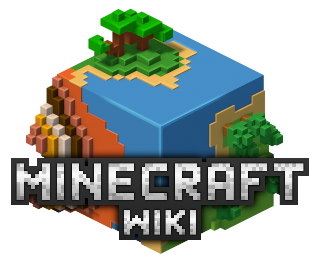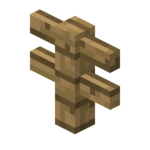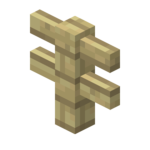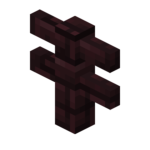(→Výroba) |
m (Revert consecutive edits by Baryduke (talk)) značka: rychlé vrácení zpět |
||
| Řádek 40: | Řádek 40: | ||
!Vstup » Výstup |
!Vstup » Výstup |
||
|- |
|- |
||
| + | ! [[Tyčka|Tyčky]] |
||
| − | ! [[Tyčky]] + [[Prkna|Dřevěná prkna]] |
||
|{{Grid/Crafting Table |
|{{Grid/Crafting Table |
||
|A1= |B1= |C1= |
|A1= |B1= |C1= |
||
| + | |A2= Prkna |B2= Tyčka |C2= Prkna |
||
| − | |A2= Dubová prkna; Smrková prkna; Březová prkna; Prkna z tropického dřeva; Akáciová prkna; Prkna z tmavého dubu |B2= Tyčka |C2= Dubová prkna; Smrková prkna; Březová prkna; Prkna z tropického dřeva; Akáciová prkna; Prkna z tmavého dubu |
||
| + | |A3= Prkna |B3= Tyčka |C3= Prkna |
||
| − | |A3= Dubová prkna; Smrková prkna; Březová prkna; Prkna z tropického dřeva; Akáciová prkna; Prkna z tmavého dubu |B3= Tyčka |C3= Dubová prkna; Smrková prkna; Březová prkna; Prkna z tropického dřeva; Akáciová prkna; Prkna z tmavého dubu |
||
| − | |Output= Plot, |
+ | |Output= Plot,2 |
}} |
}} |
||
|} |
|} |
||
| − | * |
+ | * Three (3) pieces of wood will make eight (8) fence sections with no leftover sticks. |
| + | Fences can also be handy to keep animals in a place except for cats and dogs. |
||
| − | |||
| − | Ploty mohou být také užitečné pro udržení zvířat na místě kromě koček a psů. |
||
== Výskyt == |
== Výskyt == |
||
Verze z 24. 12. 2019, 21:04
| Průhlednost |
Ano |
|---|---|
| Svítivost |
Ne |
| Odolnost proti výbuchu | |
| Tool | |
| Obnovitelné |
Ano |
| Seskupitelné |
Ano (64) |
| Flammable |
Ano |
| Drops |
Itself |
| Data value |
dec: 85 hex: 55 bin: 1010101 |
| Name |
plot |
Plot je dřevěný blok přidaný v Seecret Friday Update 8, version 1.0.17 Alpha. Pro hráče nebo stvoření je 1, 5 bloku vysoký, ale pro ostatní účely je vysoký pouze blok.
Plot zabírá střed prostoru bloků a automaticky se napojí na nějaké solidní bloky, které jsou vedle něj. Ploty se nejrychleji ničí se sekerou.
Ploty jsou také často používané k ohrazování zvířat, například prasat, slepic, krav nebo ovcí.
Výroba
| Ingredience | Vstup » Výstup |
|---|---|
| Tyčky |
- Three (3) pieces of wood will make eight (8) fence sections with no leftover sticks.
Fences can also be handy to keep animals in a place except for cats and dogs.
Výskyt
- Ploty se hojně nacházejí v opuštěných důlních šachtách.
- Také se vyskytují ve vesnicích, kde se můžou vyskytovat v podobě stolů, lamp nebo plotů.
- Fences occur in library rooms of Strongholds as railings or they form something similar to chandeliers. In the latter case, there are many torches attached to them.
Použití
A fence's primary use is for enclosing an area. Functionally, the fence serves to keep mobs and players either inside or outside. A wide area can be made monster-resistant by enclosing it in fences and lighting the inside portion heavily. This stops any monsters from spawning within the fence, and stops most monsters which spawned outside the fence from coming in; the exception is spiders, which can climb over it. In addition, while skeletons are unable to cross a fence, they can shoot over it; also, if there is not a roof, Endermen can still teleport in.
Fences can also be used as railings, especially on the edges of balconies or floating platforms. Since fences cannot be jumped over, this keeps players and mobs from falling off while still allowing them to easily see past the fence.
Fences can replace glass for windows, as mobs cannot see through them. Unlike glass, fences can be moved around trivially, and are easily renewable.
Fences can also be used to fuel a furnace, although the player would have been better off burning the 3 wooden planks used to create each fence.
Also, keep in mind that wooden fences cannot attach themselves to nether brick fences, iron bars, cobblestone walls, etc. Aside from fence gates and other wooden fences, they will not attach to some blocks, such as stairs, single slabs, ice blocks (these are transparent), pumpkins, chests or anvils.
Fences can be made into a bridge by making a 3-5 wide set of Fences off of elevated land. Then, place railings on the side of the bridge by placing fences along the sides. Afterward, place pressure plates in the center 1-3 rows.
Fences can be used for an effective water elevator, with a 2x2 shaft have the water in front and the fence posts stacked behind. This also acts as a source of air underwater, as fences are not a full solid block.
Because fences are 1.5 blocks high, they can be used to create shallow stairs (the kind you can sprint up). They have the advantage that they are transparent, so when descending you won't be surprised by monsters hiding under the stairs.
Tipy
- To craft one stack of fences you need 24 logs. This produces three stacks of sticks, which can be made into one stack of fences.
- The following does not account for gates, or extra fences needed for blocking jump routes:
- To enclose an area of L×W in size (L being length and W being width), you will need enough fences for the entire perimeter P, which will be double the sum of length and width, give or take 4 for the corners. If L and W do not include the fences, this will be P = 2L + 2W + 4. If they do, then P = 2L + 2W - 4. A classic 9×9 farmland plot will take 40 fences to surround.
- To fence a length of minecart track, you will need double the number of fences as you placed rails. (If you used 2 stacks of rails, you will need 4 stacks of fences.) This doesn't depend on how far from the rails your fences are, nor are diagonal runs any different.
- Watch out for nearby blocks outside the fence, from which monsters could jump onto the fence and then over. If you're not sure about a spot, try the jump yourself.
- Any block next to, or one space away from, the fence, is an obvious hazard. Remove the blocks, replace them with slabs, stairs, etc, or make the fence higher.
- For similar reasons, any time your fence goes downhill by one block, make the downhill side two-high for at least two blocks.
- A less obvious problem: If you build a two-high fence next to 1-high blocks, a monster (or you) can step up a half-block onto the lower row of fence (where it joins the blocks), then jump from there one block up to the top of the fence.
- If you are roofing over only part of an fenced enclosure, or your railway is going through a shallow tunnel, you will need to fence off the overhanging roof, to keep monsters from jumping down. (Also, you may need to light or fence off the roof itself.)
- Trying to build a fence around a lava pit is not a good idea, as the fence will catch fire if placed on the block directly adjacent to the lava.
Video
Fence/video
History
| Java Edice (Alpha) | |||||
|---|---|---|---|---|---|
| 1.0.17 | Craftable Fences were added. Nothing could be placed on top of fences. | ||||
| Java Edice (Beta) | |||||
| 1.3 | Fixed standing on top of fences causing players to get stuck and crashing the server in SMP. | ||||
| 1.6 | Fences made flammable and visibility improved | ||||
| 1.7 | Any block, including torches and other fences, now able to be placed on fences. | ||||
| 1.8 | Axes break fences faster. | ||||
| 1.9-pre2 | Fence collision box reduced. | ||||
| Fences now connect to solid blocks. | |||||
| 1.9-pre5 | Fence selection area changed to match collision box. | ||||
| release | |||||
| 1.0.0 | Fences no longer prevent farmland from decaying when placed below farmland. | ||||
Instructional diagram of the old stacking system.
When first implemented, the game prevented blocks from being placed above the fence but allowed the fence to be placed on a location when there is a block above it. This loophole was soon commonly exploited to allow fences to be stacked, mainly for aesthetic purposes.
The stacking process was done by creating a wall of blocks one layer shorter than the intended height of the fence and working down. Removing blocks from underneath the fence did not cause it to collapse like cacti and dveřes, so the lower layers of the wall could be replaced by fences easily, one-by-one. These rules were not applied underwater so they could be stacked just like any other block when submerged.
Before the official release of Minecraft, fence corners did not need to be complete in order to be sealed. A corner where two directions meet at a right angle could be created without the actual corner piece. This would create two separate fences which terminate next to each other without actually touching. While there is a visible gap, players and mobs will still be unable to pass through. This feature could be used to create lengths of diagonal fences, which will appear as nothing but posts, yet will still prevent anything from passing. However, in 1.0.0, the fence's collision box was fit around the fence itself (except for the 1.5 height), thus requiring the corner fence.
Issues
Problémy týkající se “Plot” jsou spravovány na issue tracker. Problémy hlaste tam.
Galerie
- 2011-10-10 15.27.59.png
Naturally occurring fences in a NPC village.
- FenceGateGlitch.png
An original case of Fences incorrectly attaching to Fence Gates.
Podívejte se také
- Fence Gate
- Nether Brick Fence
- Cobblestone Wall








